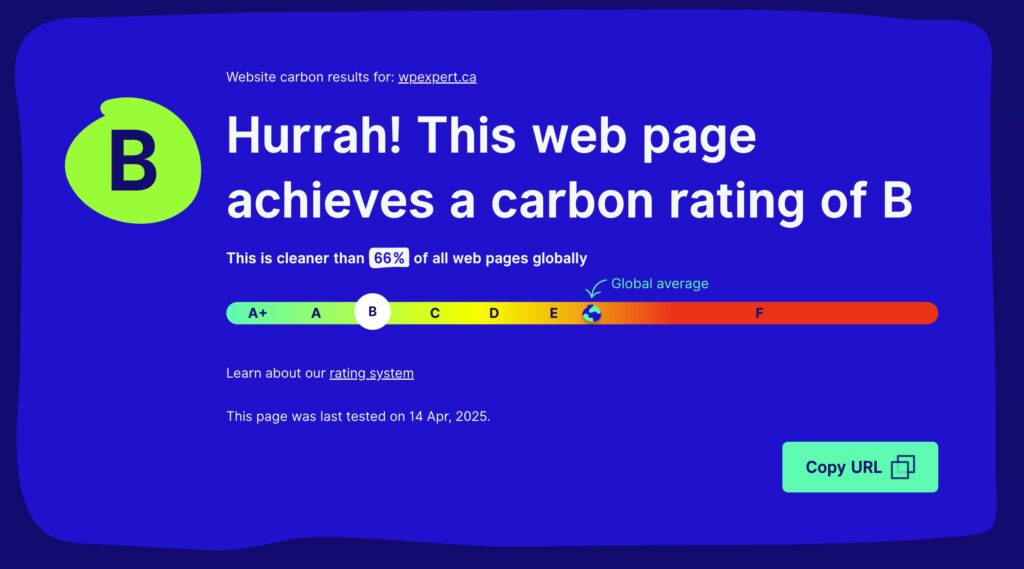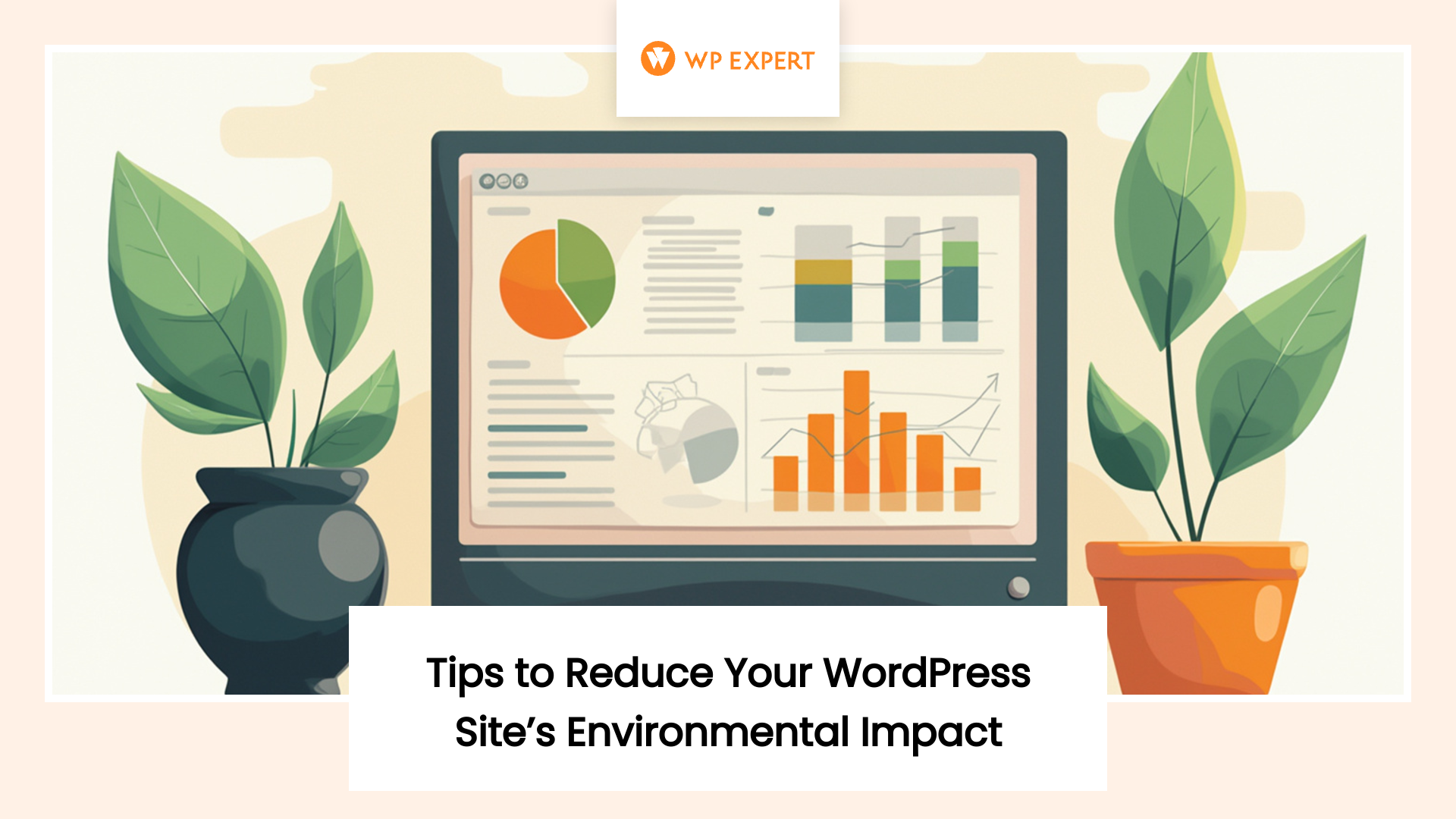The digital world has a carbon footprint, and it’s bigger than most people realize. With WordPress powering over 43% of all websites globally, the environmental impact of these sites deserves our attention.
At WP Expert, we’re committed to helping businesses reduce their digital carbon footprint while maintaining high-performance websites.
Every time someone visits a web page, it generates carbon emissions through electricity consumption during data transmission, server processing, and client-side rendering.

A typical webpage produces approximately 0.5 grams of CO₂ per pageview. For a website with 100,000 monthly visits, that translates to roughly 600 kg of CO₂ annually.
Several WordPress-specific factors can increase this environmental impact:
The good news is that optimizing your WordPress site for sustainability often aligns perfectly with improving performance, user experience, and even search engine rankings.
- Resource-heavy themes that increase page weight by up to 3 MB
- Unoptimized media files (images account for 42% of average page weight)
- Inefficient plugins introducing redundant scripts that prolong load times
- Server energy consumption from unnecessary database queries
Table of Content
Choosing Eco-Friendly Hosting
One of the most impactful decisions you can make for your website’s carbon footprint is selecting a sustainable hosting provider. Green hosting companies operate data centers powered by renewable energy or offset their carbon emissions through investments in environmental projects.
When evaluating potential hosts, consider these factors:
- Renewable energy commitments (look for 100% renewable energy)
- Server efficiency (Power Usage Effectiveness or PUE rating ≤ 1.2)
- Data center cooling systems (liquid immersion cooling reduces energy needs)
- Carbon offset programs
According to a study by Website Carbon Calculator, simply switching to a green hosting provider can reduce your site’s carbon emissions by 50-80%, making it one of the most effective sustainability measures you can implement.

WP Expert got a B! Thanks to our partner, WP Cloud who is using Green data center.
Optimizing Images for Sustainability
Images are typically the heaviest elements on a WordPress site, and optimizing them can significantly reduce your carbon footprint. We recommend implementing these image optimization techniques:
Use Modern Image Formats
WebP format reduces image sizes by approximately 30% compared to JPEG and PNG without quality loss. Modern browsers now widely support this format, making it an excellent choice for sustainable websites.
You can easily convert your existing images to WebP using plugins like WebP Express or ShortPixel. These tools can automatically serve WebP images to compatible browsers while maintaining fallbacks for older ones.
Implement Lazy Loading
Lazy loading delays the loading of off-screen images until users scroll to them, reducing initial page load size and server requests. Since WordPress 5.5, lazy loading is enabled by default for images, but you can enhance this functionality with plugins that offer more control.
Resize Before Uploading
One common mistake is uploading high-resolution images and then letting WordPress resize them through CSS. This approach wastes server resources and bandwidth. Instead, resize your images to their display dimensions before uploading them to your site.
Implementing a Lightweight Theme
Your WordPress theme significantly impacts your site’s environmental footprint. Many premium themes include bloated code, unnecessary features, and heavy JavaScript libraries that increase page size and load times.
Choose Minimalist Themes
Look for themes specifically designed with performance in mind. Some environmentally friendly options include:
- GeneratePress
- Astra
- Kadence
- Twenty Twenty-Five (WordPress default theme as of April 2025)
These themes are built with clean code and minimal dependencies, resulting in smaller page sizes and faster load times – both crucial for reducing carbon emissions.
Consider Dark Mode Options
Dark mode themes can significantly reduce energy consumption on OLED and AMOLED screens, which are increasingly common on mobile devices and newer laptops. Studies have shown energy savings of up to 63% at full brightness when using dark interfaces on these displays.
For WordPress sites, you can implement dark mode through:
- Themes with built-in dark mode options
- Plugins that offer user-togglable dark/light modes
- Custom CSS using prefers-color-scheme media queries
Optimizing WordPress Performance for Sustainability
A faster website doesn’t just improve user experience and SEO rankings – it also reduces the carbon footprint of each visit by minimizing the time servers spend processing requests and the energy used to render pages on users’ devices.
Implement Caching
Caching creates static versions of your dynamic WordPress pages, reducing server processing for each visitor. Effective caching can reduce server load by up to 80%, directly translating to energy savings.
We recommend configuring:
- Page caching (with plugins like WP Rocket or W3 Total Cache)
- Browser caching (through .htaccess configuration)
- Object caching (especially for high-traffic sites)
Minimize HTTP Requests
Each element on your page (scripts, stylesheets, images) requires a separate HTTP request. By reducing these requests, you can significantly improve load times and reduce energy consumption.
Consider implementing these techniques:
- Combine CSS and JavaScript files
- Use CSS sprites for interface elements
- Remove unused plugins and their associated assets
- Implement resource hints like preconnect and preload
Rethinking Plugin Usage
WordPress plugins extend your site’s functionality but can significantly impact its carbon footprint. Each active plugin adds code that must be loaded, processed, and executed, consuming additional server resources and increasing page weight.

Conduct a Plugin Audit
Start by evaluating your current plugins with these questions:
- Is this plugin actively used and necessary for site functionality?
- Could this functionality be achieved through simpler means (like custom code)?
- Are there lighter alternatives available?
- Does this plugin load resources on every page, even where not needed?
Remove plugins that don’t pass this evaluation to immediately reduce your site’s resource consumption.
Choose Lightweight Alternatives
When selecting plugins, prioritize those with minimal impact on performance:
- Contact form plugins like Formidable Forms Lite instead of heavier alternatives
- SEO frameworks like The SEO Framework rather than feature-heavy options
- Simple social sharing buttons instead of third-party scripts that track user behavior
It’s often better to have multiple single-purpose lightweight plugins than one massive “Swiss Army knife” plugin that loads unnecessary code on every page.
Database Optimization for Energy Efficiency
Your WordPress database accumulates clutter over time, leading to inefficient queries that waste server resources and increase carbon emissions.
Regular Clean-ups
Implement a regular database maintenance routine to clean:
- Post revisions (limit them to 2-3 per post)
- Trashed posts and comments
- Spam comments
- Expired transients
- Orphaned metadata
Plugins like WP-Optimize can automate this process, scheduling regular clean-ups to keep your database lean and efficient.
Optimize Database Tables
Database tables can become fragmented over time, increasing the resources needed to read and write data. Regularly optimizing these tables (similar to defragmenting a hard drive) can improve efficiency.
Most database optimization plugins include this functionality, or you can perform this manually through phpMyAdmin by selecting tables and using the “Optimize Table” function.
If you are on one of our care plans, we are doing it automatically for you every week.
Content Delivery Strategies
How you deliver content to visitors significantly impacts your carbon footprint. Strategic delivery minimizes data transfer while maintaining a high-quality user experience.
Implement a Content Delivery Network (CDN)
CDNs distribute your website content across multiple servers worldwide, serving visitors from locations geographically closer to them. This reduces data travel distance, lowering both latency and energy consumption.
Moreover, CDNs typically use highly optimized servers and compression techniques, further reducing the environmental impact of content delivery.
Adopt Progressive Loading Techniques
Progressive loading delivers the most crucial content first, allowing users to start interacting with your site before all elements have loaded:
- Critical CSS rendering path optimization
- Asynchronous loading of non-essential scripts
- Progressive image loading (blurred placeholders that sharpen as they load)
These techniques improve perceived performance while reducing unnecessary data transfer for visitors who don’t scroll through entire pages.
Measuring and Monitoring Your Carbon Footprint
To effectively reduce your WordPress site’s environmental impact, you need to measure it. Several tools can help you quantify your site’s carbon emissions and track improvements over time.
Website Carbon Calculator
The Website Carbon Calculator provides an estimate of how much CO2 your site produces per pageview and compares it to industry averages. It also offers specific suggestions for improvement based on its analysis.
Performance Monitoring Tools
Since performance and sustainability are closely linked, tools like Google PageSpeed Insights, GTmetrix, and WebPageTest can help identify areas where your site could be more efficient.
Regular monitoring allows you to catch regressions quickly and measure the impact of your optimization efforts over time.
The Business Case for Sustainable WordPress Sites
Reducing your WordPress site’s carbon footprint isn’t just good for the environment – it makes business sense too.

Performance Benefits
The same optimizations that reduce carbon emissions also improve site performance:
- Faster load times lead to lower bounce rates (a 1-second delay reduces conversions by up to 7%)
- Improved core web vitals boost SEO rankings
- Better user experience increases engagement and conversions
Cost Savings
Efficient websites consume fewer server resources, potentially reducing hosting costs, especially for high-traffic sites. Less data transfer also means lower CDN and bandwidth costs.
Brand Reputation
Environmental consciousness is increasingly important to consumers. Showcasing your commitment to sustainability can enhance your brand image and appeal to environmentally conscious customers.
According to recent studies, 78% of consumers say a company’s environmental practices influence their purchase decisions.
WordPress Community Sustainability Initiatives
The WordPress community is increasingly recognizing the importance of sustainability in web development. In 2023, the WordPress Project established a formal WordPress Sustainability Team to develop guidelines and best practices for environmentally friendly WordPress development.
Though there have been some organizational changes since then, the community continues to work on sustainability initiatives, with developers and agencies collaborating to create more eco-friendly themes, plugins, and development practices.
Future Trends in Sustainable WordPress Development
The field of sustainable web development is evolving rapidly. Here are some emerging trends to watch:
Green Coding Practices
Developers are increasingly adopting coding standards that prioritize efficiency and minimal resource usage. This includes writing cleaner code, implementing efficient algorithms, and avoiding resource-intensive practices.
AI-Powered Optimization
Artificial intelligence is beginning to play a role in website optimization, automatically implementing performance improvements and reducing unnecessary code and resource usage without human intervention.
Carbon-Aware Design Systems
New design systems are emerging that prioritize low-carbon approaches from the ground up, incorporating sustainability into every aspect of website planning, design, and development.
Conclusion: Small Changes, Big Impact
Reducing your WordPress site’s carbon footprint doesn’t require a complete redesign or significant investment. By implementing the strategies discussed – from choosing green hosting to optimizing images, streamlining code, and monitoring performance – you can make a substantial positive environmental impact while improving your site’s performance and user experience.
At WP Expert, we’re committed to helping our clients build more sustainable WordPress websites. Whether you’re looking to optimize an existing site or create a new eco-friendly web presence, our team has the expertise to help you achieve your sustainability goals without compromising on functionality or design.
Remember that sustainable web design isn’t just about reducing carbon emissions – it’s about creating better, faster, and more efficient websites that serve both your business goals and our shared environmental responsibility.
Every byte saved is energy conserved. Every optimization is a step toward a more sustainable digital future. By making your WordPress site more environmentally friendly, you’re not just helping your business – you’re helping the planet too.
